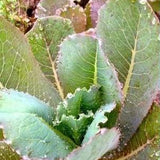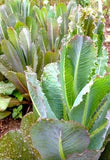Bronze Syrian Lettuce
Lactuca sativa
Open-headed green romaine lettuce with a pretty bronze tint and a silver cast. Plants grow 8" high and 4-6" in diameter with violet stems, and are very heat tolerant and slow to bolt. Tastes like lettuce! Tastes good! This seed is from Homs, Syria and was donated by the Near East Foundation to the US National Plant Germplasm System in 1949. In 2014, it was shared with Roughwood Seed Collection by the Experimental Farm Network, who has a particular interest in preserving crops from parts of the world experiencing farmland loss due to war and natural disaster. Homs is now known as "the capital of the revolution," and has experienced extreme violence against those resisting the Bashar al-Assad regime. We hope to rematriate Syrian seeds to those looking to grow a taste of home, whether in their homeland or from afar.
Days to maturity: 40-60
Seeds per pack: 100
Germination rate: 81% on 11/13/2025
Planting / harvesting notes
Seed every 1" in rows 8-12" apart, 1/4-1/2" deep. Keep watered until germination. Thin to every 8". Harvest when you can't wait anymore!
Seed keeping notes
Lettuce is very much self-pollinating, but give at least 10 feet between plants (we give at least 35 feet) to avoid unwanted cross-pollination from flying insects. Allow the plants to bolt and flower. Often, flowering lettuce benefits from simple staking (we tie several plants together) so that the flowers and seedheads do not fall to the ground. Seed is ripe when the flowers turn to 'feathers', which are fluff balls like dandelions. In the moist summers of Pennsylvania, we harvest the entire seedheads when at least 50% of the plant has gone to seed. If there are dry days in the forecast, feel free to wait longer for more ripe seed. Cut the seedheads a few feet down, and allow to dry about a week in a sunny dry place like a greenhouse, sunny window, or even a car seat. Later, wearing a handkerchief or mask to avoid breathing in the feathers and dust, bang the seedheads in a bucket allowing the seed to fall to the bottom. The ripest seeds fall, the least ripe stay in the plant, so do not over do it. Sift through strainers to remove the large chaff, and then use your breath, a fan, or the wind to carefully blow off the smaller dust.







